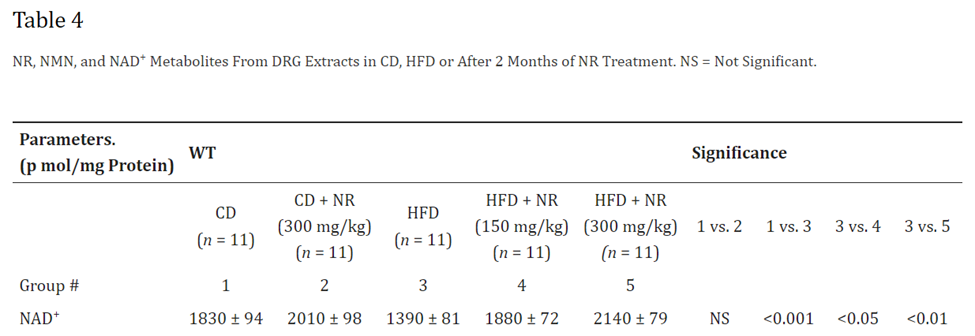NAD+ Precursors NMN and NR Prevent Nerve Fiber Degradation in Diabetes
Scientists find that boosting NAD+ with NMN and NR supplementation alleviates diabetes-related nerve fiber degeneration and loss in rodents.
Highlights
- Diminished NAD+ levels are restored by nicotinamide riboside (NR) treatment in nerve fibers damaged by diabetes.
- Administering nicotinamide mononucleotide (NMN) to rats or mice with experimentally-induced diabetes improves nerve function and prevents nerve fiber loss.
- These findings suggest that supplementing with the NAD+ precursors NMN or NR could prevent the degradation of nerves associated with diabetes by boosting NAD+ levels.
When the concentration of sugar circulating in our blood becomes too high, as with diabetes, it can begin to degrade our neurons, a condition called diabetic peripheral neuropathy. Research has indicated that falling levels of the molecule NAD+ (nicotinamide adenine dinucleotide) – involved in thousands of cell reactions for the generation of energy – worsens this nerve fiber degradation. While strict control of blood sugar levels can prevent further nerve damage, no known therapy currently prevents or reverses diabetic peripheral neuropathy. However, a new study suggests that boosting NAD+ may do the trick.
Published in the International Journal of Molecular Science, Russel and colleagues from the University of Maryland studied the effects boosting NAD+ on diabetic peripheral neuropathy by treating diabetic mice with the NAD+ precursor, NR. They found that NR treatment raised NAD+ levels in the nerve fibers affected by diabetes. The Maryland-based researchers also found that another NAD+ precursor, NMN, prevented nerve fiber dysfunction as indicated by increased nerve conduction velocity – the speed at which electrical signals travel along nerves. Furthermore, NMN and NR prevented nerve fiber deterioration. These findings suggest that using NAD+ precursor supplements like NMN or NR could potentially slow or prevent the progression of diabetic peripheral neuropathy in patients with diabetes.
“Our results show that [injection]of NMN or dietary administration of NR prevented the pathogenic pathway in diabetic neuropathy,” said Russel and colleagues in their publication.
NR Restores Nerve Ending NAD+ Levels
To examine the effects of feeding NR to mice with diabetes on NAD+ levels, Russell and colleagues induced diabetes in young, three-month-old mice by feeding them a special high-fat diet. The Maryland-based research team then fed the diabetic mice 150 mg/kg/day or 300 mg/kg/day of NR by mixing it in with their food. They found that NAD+ levels in the dorsal root ganglion – bundles of neurons in the spinal cord – of the diabetic mice were substantially reduced. However, NR-treatment more than normalized NAD+ levels, increasing them by 17%. These results illustrate that supplementing with an NAD+ precursor rescues falling NAD+ levels in diabetic peripheral neuropathy.

NMN Treatment Rescues Nerve Firing in Diabetes
Russel and colleagues next determined if restored NAD+ concentrations rescue failing nerve function in diabetic rats. To generate a chemically induced diabetes model, the team of researchers treated rats with the chemical streptozotocin. They found that injecting the diabetic rats with 50 mg/kg or 100 mg/kg of NMN improved the nerve conduction velocity, an indicator of a healthy functioning nerve. These findings demonstrate that NMN can rescue nerve function in models of diabetes.


NMN Restores Nerve Fiber Counts
The Maryland-based research team next showed that diabetic rats had about half the nerve fibers as non-diabetic rats. However, NMN treatment prevented this loss. These findings illustrate that not only does NAD+ supplementation increase NAD+ levels in nerve fibers, but that it also drives increased nerve conduction velocity and restores nerve fiber density.


Research has previously shown that increasing cellular NAD+ levels with precursors like NMN or NR likely stimulates the function of proteins called sirtuins. Sirtuins activate the genes necessary to drive the production of new, cell energy-generating mitochondria. Thus, increasing sirtuin activity with higher NAD+ levels could also stimulate the production of new mitochondria. Since the energy that mitochondria produce keeps cells functioning and alive, this may explain why higher NAD+ levels from NMN or NR supplementation leads to better nerve function and higher nerve fiber density.
NMN and NR May Rescue Nerve Function in Diabetic Peripheral Neuropathy
Numerous studies in mice have shown that boosting NAD+ by supplementing with precursors like NMN or NR alleviates age-related conditions like metabolic disorders, neurodegenerative diseases, obesity, and cardiovascular ailments. This is the first study known-to-date showing that NAD+ precursor supplementation may prevent the progression of diabetic peripheral neuropathy in rodents. Although these results are promising, please keep in mind that the experiments were performed in rodents. Future clinical trials will need to examine whether these findings apply to humans. Who knows? NAD+ supplementation may become a key method to treat diabetic peripheral neuropathy, a disorder which no current treatment option sufficiently confronts.
A remaining question not addressed in this study is whether NMN or NR supplementation could reverse the nerve damage caused by diabetes. Perhaps long-term NAD+ precursor treatment could cause a complete restoration of nerve fiber density after they have been lost, which would be advantageous for patients living with diabetic peripheral neuropathy.

